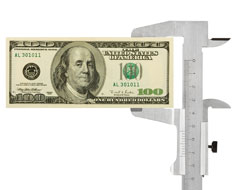Q: The corporate office and I often debate what an effective marketing program is. How should we evaluate marketing ideas, and what are realistic expectations from a marketing program?
A: A franchisee recently posed these questions to me, and I know they’re points of contention in many franchisee-franchisor relationships. It’s smart to try to get on the same page about your marketing investments, so let me lay out some principles and a process that will help.
Like every other expense, you shouldn’t proceed with a marketing program unless you expect a positive return on investment (ROI). But marketing programs don’t lend themselves to easy ROI calculations. It’s difficult to assign a precise value to the outcomes of certain marketing programs, like those intended to favorably influence brand perceptions or generate word of mouth. We all know they’re important, but what are those really worth?
ROI calculations also usually reflect only short-term, discrete results; it’s rare for any single marketing activity to be directly responsible for new net revenue. Customers typically respond only after being repeatedly engaged by a series of marketing activities, so an ROI evaluation may not adequately account for all the causes and effects. Plus there are many variables outside marketing that affect restaurant performance, making it difficult to isolate the results attributable to a single marketing program.
If you’re serious about evaluating marketing ideas, you need more than a simple measurement—you need a disciplined process. And the process shouldn’t start with the marketing idea, because this yields a subjective discussion. Instead of talking about “what,” start with “why.” Start by setting clear objectives.
Everyone involved should share a common understanding of the marketing objectives. Possible objectives include: increase brand awareness; drive trial by new customers; increase the number or frequency of repeat visits from existing customers; increase average check; improve brand perceptions; or get sign-ups for e-mail or mobile marketing.
Be as specific as possible, and keep in mind that marketing isn’t a cure-all. Marketing can’t sell what isn’t there or make people buy things they either don’t want or can’t afford, so your product needs to be compelling. Marketing also can’t repair a bad experience, improve satisfaction, or fix a flawed business—that’s operations’ job.
It’s also important to recognize that no marketing program will make you an overnight success. It takes time, consistency, and follow-up for most marketing efforts to gain traction, so set realistic objectives and plan for reasonable time frames.
Once you’ve set the general objectives, define how you will measure them and what success looks like. Again, you should be specific; make your definitions data-based and time-oriented. For example, if your objective is to increase repeat visits, you might specify that you want to get a second visit from 50 percent of new customers within one week of their initial visit. Or if you want to get the word out about your brand, your specific objective might be to get 200 retweets or Facebook “likes” about a special offer within a week of its introduction.
From there, design a program to meet those expectations. Different programs will take different approaches, but there are some general criteria for effective marketing:
Clear and simple. Today’s consumers don’t have the attention spans or patience to read a lot of copy or to follow complicated steps to participate in a promotion. When it comes to messaging, remember less is more.
Different and creative. Just because it’s clear and simple doesn’t mean it has to be boring. To break through the clutter, inject a surprise and express your brand personality.
Focused. Don’t try to do too many things or appeal to too broad of a target audience. A series of smaller targeted efforts is likely to produce a better bang for your buck than a mass campaign.
Include a call to action. Be clear about what you want people to do as a result of the program—come to your store, visit your Facebook page, or tell a friend, for example. Including a time frame for response is one of the best ways to get people to take action. Even if the effort is only intended to raise awareness or improve your image, make sure you include ways for people to get more information or raise their hands for additional contact.
Above all else, your program should be track-able. You want to measure results by tracking responses to specific efforts. Track your fliers and direct mail, for example, by giving customers a specific code to use when responding (like “DH” for a door hanger campaign). Try using different toll-free numbers or URLs for each medium or campaign. Also, train your employees to ask all prospective customers where they learned about you and set up a system for tracking the responses.
When you use this process, you get accurate results by which to evaluate a program. Then the conversation between franchisor and franchisee can be based on data instead of opinions, and you can work together to develop criteria that can be applied to new marketing program ideas going forward.







